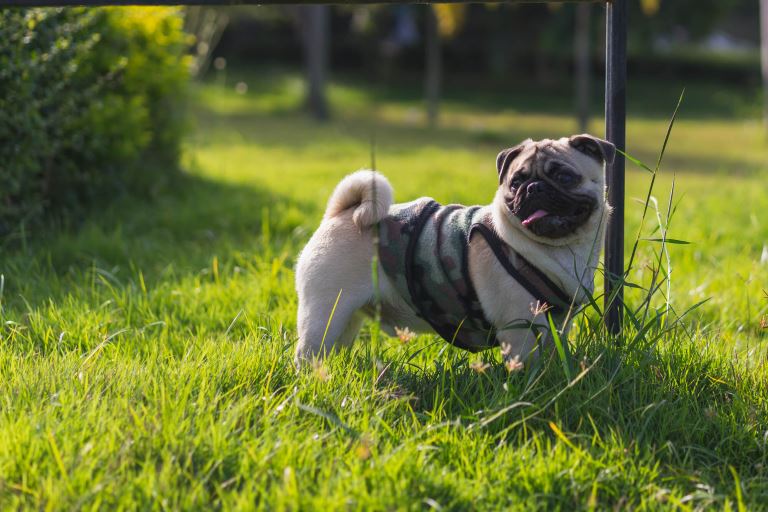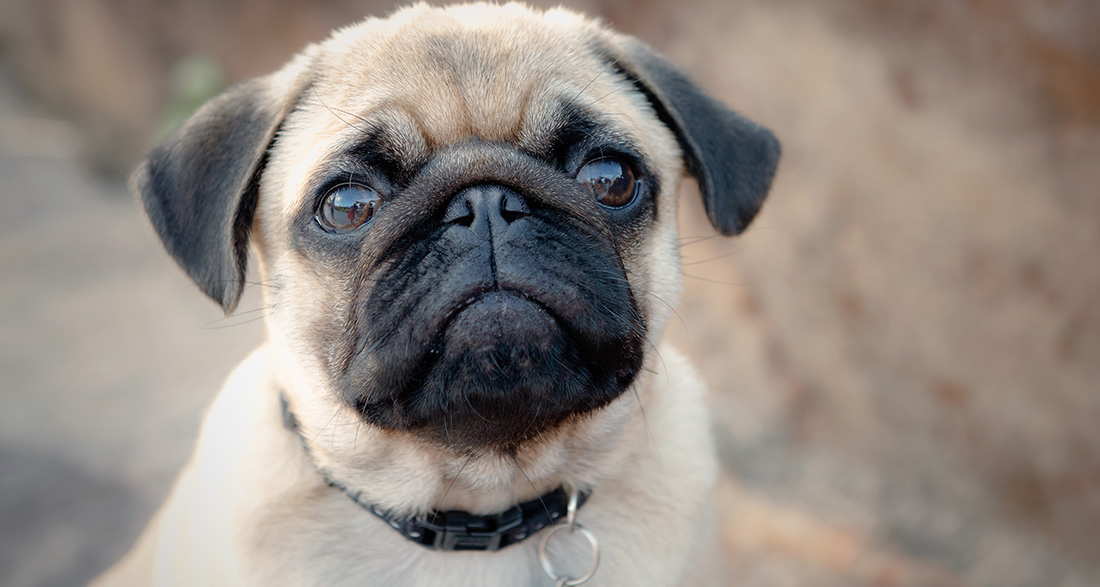The wrinkled face, compact body, and snorting breath make the Pug one of the most well-known dog breeds globally. These small dogs are suitable for everyone, whether families, individuals, or seniors. Learn everything about the history, character, care, and keeping of Pugs in this profile.
History of the Pug
The Pug is now a popular companion dog, recognized for its friendly and lively nature. But when did the breed as we know it come into existence?
The origin of the breed likely dates back over 2000 years to the Chinese Empire. The Chinese selectively bred the breed as a royal dog from some mastiff-like dogs. It was a privilege of the emperor to own and touch this dog breed. However, dogs not suitable for breeding were likely sold at a high price to the public. The breed also spread as the Chinese emperor gifted Pugs to other dignitaries. Only in the early 16th century did the ancestors of the breed arrive in Europe with the Dutch East India Company. The Pug found great favor, especially among noblewomen, and was immortalized in some historical paintings.
The Naming of the Pug
Most likely the pug breed’s name came from marmoset monkeys, which were also known as Pug monkeys. Marmosets were popular pets in the early 1700s, and their faces look much like those of Pug dogs.
In England, the breed was officially recognized and later included in FCI Group 9. In the group of companion and toy dogs, the Pug belongs to Section 11, the small mastiff-like dogs. Over time, unfortunately, the breed evolved into an absolute fashion dog, and the trend toward a flatter nose became popular. Since this trait led to breathing difficulties in Pugs, the official FCI standard was changed in 2010. Today, breeders are returning to the original appearance, where the nose protrudes slightly more.
Breed Overview
GROUP: Toy
HEIGHT: 10 to 13 inches
WEIGHT: 14 to 18 pounds
TEMPERAMENT: Affectionate, sweet-tempered, playful
COAT: Short and smooth
COAT COLOR: Fawn or black with a black face mask
HYPOALLERGENIC: Yes
LIFE SPAN: 13 to 15 years
Appearance of the Pug
Pugs, with their distinctive appearance, have been winning the hearts of many people for centuries. Their compact build, characteristic facial features, and unique coat make them unmistakable.
Body Structure and Facial Features:
The Pug is characterized by a compact, muscular body that, despite its small size, exhibits surprising robustness. Its head is large and round, with a flat muzzle that makes its face particularly distinctive. The Pug’s large, dark eyes radiate a lot of charm and expression, being one of its most prominent features. Pugs have small, high-set ears that add even more personality to their expression.
Coat Structure and Color Variants:
The Pug’s coat is short, smooth, and shiny. This coat structure significantly simplifies grooming, making them an ideal companion for those who don’t want to invest much time in coat care. Pugs come in various colors, with the most common variants being fawn, black, and silver. Each of these colors gives the Pug its own unique and unmistakable charm.
Traits and Characteristics
Even though it looks a bit grumpy, the Pug is a dog with a charming, cheerful, and friendly character. Despite its small size, this intelligent dog is an independent companion who charmingly communicates its desires to its owner. It usually gets along well with other dogs but is sometimes misunderstood due to its snorting breathing. The Pug is not easily disturbed and does not have a strong guarding or hunting instinct.
Toward its human family, the small dog is sensitive and always attentive, making training relatively easy. Since the breed was originally bred as a lap dog, Pugs prefer to be with their owners at all times and do not like being left alone at home. They also get along well with children and are ideal for first-time dog owners.
| Affection Level | High |
| Friendliness | High |
| Kid-Friendly | High |
| Pet-Friendly | High |
| Exercise Needs | Medium |
| Playfulness | High |
| Energy Level | Medium |
| Trainability | Medium |
| Intelligence | Medium |
| Tendency to Bark | Low |
| Amount of Shedding | High |
Acquiring a Pug
Before buying a Pug, you should be aware that you are committing to the animal for at least 12 years. You must be willing to dedicate yourself to the pet during this period and take good care of it. The small dog doesn’t mind whether you have a large house with a garden or a small city apartment; it feels comfortable anywhere. Not only because of its friendly nature, it is a great family dog and is also compatible with small children. Since the dog does not like to be alone, you should not leave it alone for long periods or go on vacation without it.

Depending on where you buy your puppy, the price can vary widely. For a healthy, purebred puppy from a breeder, expect prices of not less than $1000. However, it is worthwhile to pay this much to get a well-groomed and healthy dog. It is particularly important that the parent animals have free breathing and a relatively long nose. Pugs in need, looking for a new home, can also be found in shelters.
Development and Training of the Puppy:
Despite its small size, the little Pug needs consistent training. These intelligent dogs quickly understand what their owner wants from them. Due to their independent nature, they can be a bit stubborn, so you need to make it clear who is in charge early on. It is particularly important to socialize the dog at a young age so that it can get along easily with other dogs and people. Puppy training classes can be a great idea, especially for puppies.
How to Keep a Pug?
Activities with the Pug:
The Pug is a dog that would like to be active but cannot due to its physical abilities. Depending on how pronounced the dog’s shortened nose is, it can engage in more or less sports. Overall, the breed does not have a particularly high exercise requirement. Occasionally, they prefer to laze on the sofa and have their bellies scratched. Short walks and fun games are to their liking. Pugs are absolutely unsuitable for people who want to engage in sports successfully with their dog. Their compact body structure and flat nose hinder them in any physical activity.

Health and Care of the Pug
The Pug can suffer from various diseases, so you should consistently ensure enough exercise and a healthy diet. With improper care, the dog is prone to overweight and illness. You should also regularly check and clean the large eyes and facial folds. The shiny, short coat requires little care, but it sheds heavily.
Breathing Problems and Overbreeding:
Due to their short face and flat nose, many Pugs suffer from breathing problems. This breed-specific characteristic, known as Brachycephaly, can lead to severe breathing difficulties, especially in heat or exertion. Overbreeding has often exacerbated this issue, sacrificing the health of the animals for a more extreme appearance.
Modern Breeding Practices:
In recent years, there has been a positive development in breeding practices. Modern breeders increasingly focus on highlighting health aspects. By consciously selecting breeding animals and using health checks, they strive to improve the breed. An example of this is the Retro Pug, a variant of the Pug developed by crossing with longer-nosed breeds to improve the airways and thus enable a healthier life.
Awareness of the issue of breeding-related health problems in dogs has led more and more people to prioritize the health and well-being of the animals. This results in more responsible breeding and a more hopeful future for these lovable four-legged friends.
Interesting and Worth Knowing
The Retro Pug:
As a number of animal welfare advocates believe that Pug breeding is inhumane, there is a trend to return to the old appearance of the breed. Modern Pugs often suffer from breathing problems due to their flat noses, are not particularly agile, and tend to be overweight. Breeders specializing in the so-called Retro Pug focus on breeding the original, longer-nosed Pug. Not without reason, these dogs are also referred to as sporty Pugs, as they are considerably more active and agile than their overbred relatives.


